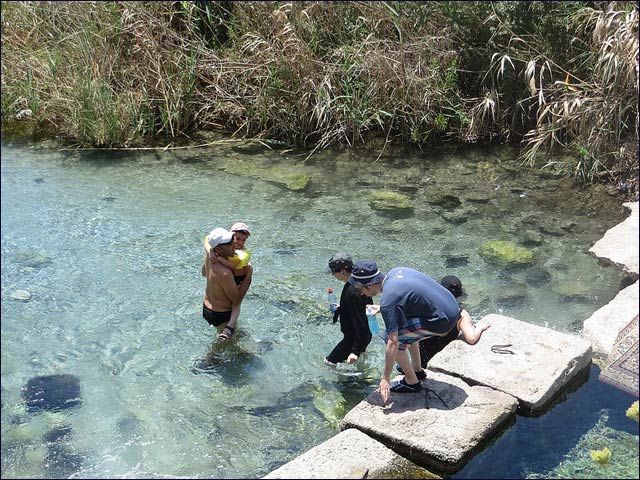By Sarah Carnvek
There is nothing wrong with staying on Israel's beaten tourist track of Jerusalem, Tel Aviv, the Dead Sea and Eilat. But should you be intrigued to step off, the slopes of Mount Gilboa and its environs have enough activities to keep you busy for weeks.
Visitors to the Gilboa (which is actually a ridge and not one single mountain) usually come for the flowering season in February and March. The carpets of red and purple irises, orchids and anemones attract tens of thousands to this Galilean green spot.
And while the flowers in bloom are indeed spectacular – most notably the black-purple Gilboa Iris -- there's no need to squeeze in a visit to this area when everyone else comes. The Gilboa area is equally famous for its history, views, hiking and biking trails and natural springs.
"It's a day of fun out in Israel's nature," says Shlomy Gabay, a tour guide/storyteller who specializes in guiding families.
Located in the Lower Galilee region, 650 meters above sea level, there's always a breeze on the 18-kilometer-long mountain ridge. The Gilboa Scenic Road is the best path to follow when exploring this area. Type “Route 667” into your GPS mapping system and hit “go.”
Road to beauty
The scenic road follows the ridges of Mount Gilboa. All along the route – and especially just off the paved road – are amazing lookout points of the Jezreel Valley below.
Visitors can view fishponds, the birds they attract, Mount Tabor, the mountains of the Jordan Valley and, on a clear day, Mount Hermon at the northern tip of Israel. There are many biblical sights and historical points as well.
Mount Gilboa's history is filled with strife. According to the Bible, it was here that King Saul and his sons Jonathan, Avinadav and Melchishua died fighting the Philistines. Today, the Gilboa peaks and communities nearby are named in their memory -- Mount Saul, Mount Jonathan, Har Giborim (“Heroes Mountain”), Mount Avinadav, Mount Melchishua.
But don't be put off by their tragic history. These places are full of life today. Mount Saul and Saul's Shoulder nearby are the main areas of recreation options. Stop at either of these two places for trails, picnic spots, playgrounds, hang-gliding, and archaeological finds.
 Cooling off at the Park of Springs. Photo by Shlomy Gabay
Cooling off at the Park of Springs. Photo by Shlomy Gabay Back in the car, continue along the Scenic Road. The Vinya Overlook offers more picturesque landscapes. Visitors can also see the hill of Moreh where the Philistines assembled to fight Saul; Harod Valley and Mount Tabor (traditional site of the Transfiguration of Jesus).
Then make a stop at the Gilboa Iris Nature Reserve. If you're here in season, the flowers in bloom will no doubt impress. Off season, take the path through the reserve to the watchtower at Mount Barkan and enjoy the scenery along the way.
Forests and springs
Visitors feeling a bit more active should come to hike, bike and swim.
Mount Barkan is a good launch pad for hiking and biking. There are a number of trail options leading from the parking lot. Follow signs to the observation tower (brilliant views) or, if you're looking for a difficult trail, head over to the Sergeants Spring (Ein Hasamal) and the Hidden Valley.
Another option is to hike in a group with the
Israel Sport for All association that organizes an annual two-day hike through the Gilboa woods and nature reserve.
Or pack a swimsuit and take a dip in the Gilboa area's natural springs. There's
Harod Spring that bubbles in Gideon's Cave on the slopes of Mount Gilboa; the always-warm natural springs at
Gan HaShlosha National Park – also called the Sachne -- that beckons families year-round; and the ancient Crusader fortress, Belvoir, in the
Valley of Springs.
Another point of interest at the base of the mountain includes the ancient synagogue at
Beit Alpha National Park at the foot of the northern slopes of the Gilboa ridge, boasting an amazing mosaic floor.
Whether you're a solo tourist or part of a family, with older companions or younger travelers, Mount Gilboa ridge is popular because it is accessible to everyone and offers different levels of touring.
"Come by car, in a golf cart, ride a bike, walk, swim, however you want," says Gabay. "Come and learn the history of the Gilboa or just see its beauty. It's not about ticking off 'I've been there.' Mount Gilboa is for all ages. It's the place to be."